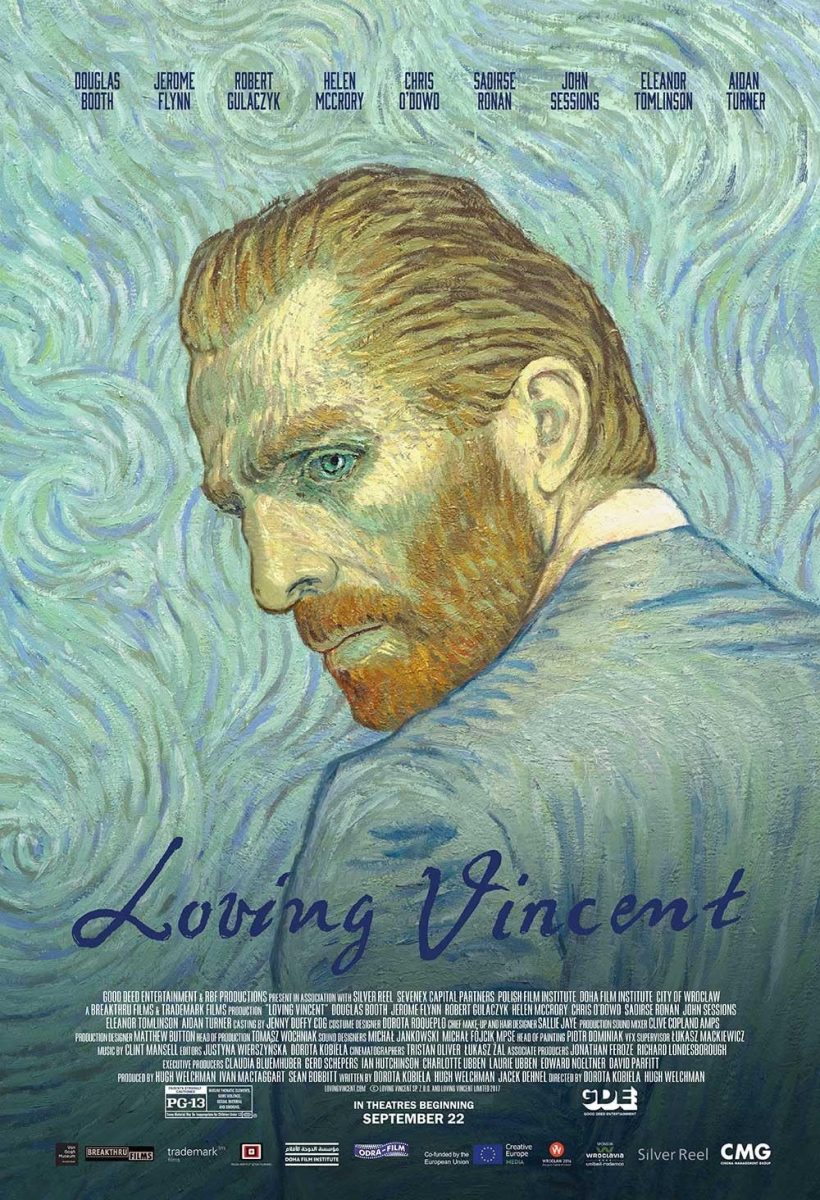The story of Vincent Van Gogh is one known by many. Every year, millions of people travel across the world to visit the museums where his 900+ paintings are exhibited. To tell Vincent’s story through a book or movie, is often a story of tragedy. And yet, his art and his life, though deeply saddening, was equally full of beauty.
On Monday, September 23, I made my way to Healdsburg with my mom to a restaurant and music venue called Little Saint. The temperature was close to 90 degrees and I felt sluggish as the heat bounced off the pavement and heated my face. When we stepped inside the restaurant, cool relief met us. It was a quaint little area with two bars and open seating, but instead of walking further in, we turned from the people dining and chatting and took a staircase leading to the second level. There was a variety of seating across the floor, a small stage at the front with three chairs and above them, a screen projecting the words “Loving Vincent.” What was particularly exciting about this showing was that the two co-directors, Dorota Kobiela and Hugh Welchman, would be present after the movie to discuss the creative process and answer questions. I had heard of the movie title before and knew that it detailed aspects of the Dutch painter Vincent Van Gogh’s life. I had also heard that there were hand-painted, animated elements but apart from that I didn’t know much. What I hadn’t been expecting was a movie that was entirely hand-painted.
The plotline of the movie is simple: the setting is France; the year is 1890, not long after Vincent Van Gogh has died by suicide. The leading character, Armand Roulin, son of the postman who delivered Vincent’s letters, is sent by his father to deliver Vincent Van Gogh’s final letter to his brother. The task takes Roulin on a journey not only through France but through Vincent’s life. Along the way, he meets various people who knew Vincent and receives various sides of the story of his life, piecing together his childhood, work as an artist, and his last days before his death. The storyline is constructed similarly to a murder mystery, with each person Roulin meets acting as witnesses, and, at some points, suspects. It is a unique take on Vincent Van Gogh’s story but was possibly the most effective way of telling his life through flashbacks and the accounts of those around him. And of course, the aspect of the movie that is most crucial to the story, is its medium.
Released in 2017, “Loving Vincent” was animated using 65,000 hand-painted oil frames, a process that took over seven years to complete. The idea came from Dorota Kobiela, one of the co-directors after she had experimented with hand painted animation. She had studied Van Gogh’s work while receiving an art history major at the Academy of Fine Arts in Warsaw, Poland and, like many, had been moved by and felt personally connected to Vincent Van Gogh’s art and story. Her co-director and husband Hugh Welchman had worked with unique forms of animation before with the 2006 film “Peter and the Wolf,” and together with their unique skill sets and 125 professional oil painters, they brought “Loving Vincent” to life.
The movie was beautiful beyond words. From the moment it starts you feel as if you are moving and walking within Van Gogh’s work. The colors alone were instantly captivating but it was the sense of movement that came with each brush stroke that stood out to me. Even when characters or objects were still, there was a sense of ineffable life in them. The detail in each character’s face, especially their pained and emotional expressions was also fascinating to watch, especially on a large screen. It was unlike anything I had ever seen, which makes sense considering there has never been a movie like it before. Not only were the visuals stunning but the dialogue was just as moving. The best I can describe the interactions between characters without giving too much away is complexly emotional. Not just sad over Vincent’s death or reminiscent of when he was alive, but a complex combination of every emotion that makes us human. This range of emotions is expressed differently throughout each character, some more sympathetic to Vincent than others, adding to the complexity of his story. My favorite message that came through in the movie was that it acknowledges the tragic events of Vincent’s life without making his life story a tragedy. I was lucky enough to visit the Van Gogh Museum in Amsterdam, The Netherlands in the summer of 2023 and one of my favorite written panels asserted that Vincent, though often characterized as the “tortured artist” archetype, was so much more than his suffering, and this is shown through his art. He saw the beauty and light in life and depicted it in his paintings, even though it deeply contrasted the feelings he dealt with. The end of the movie reveals this so clearly with an excerpt from one of his letters, and though I won’t quote it exactly and give it away, he adamantly expresses his desire for his heart and love to be seen by other people. “Loving Vincent” is a reminder that there is beauty in the world if only we are willing to see it.
Listening to the directors talk about the creation and process this movie entailed was a breath of fresh air to hear in an industry that is constantly shelling out remakes, sequels, and unoriginal storylines that no one is asking for. I’m not trying to suggest that every movie needs to take over seven years and be made up of 65,000 hand-painted frames, but every movie should come from the same passion for storytelling and creating something that will resonate with people. Every movie should have the same dedication to create a story that speaks to peoples’ appreciation for humanity, art, and life itself, in all its pain and beauty. The directors took a risk with a film that had so much time and effort put into but that speaks so clearly to these themes, and it was incredibly well received by audiences from all over the world. Kobiela and Welchamn told of their experience at the premier of the movie in Amsterdam, where they met a woman who had driven over seven hours just to hug the directors and thank them for the movie they had created. What more could you ask for as a director? Directors, in my opinion, have the power and opportunity to bring their visions and the brilliantly creative work of others to life. What better way to grasp that opportunity than to create something that moves people to that great an extent? “Loving Vincent” is a perfect example of a community that can be built around those who appreciate art, especially art that takes its time, careful not to miss any detail. It is representative of the passion behind independent films and filmmakers, despite limited budgets, resources, and no guarantee that it will be well received. “Loving Vincent” is a love letter to the simple beauties that life has to offer, and depicts how Vincent Van Gogh was able to capture these things with a brush and paint. Do yourself an immense favor and watch it, to enjoy his art and story for yourself.


















